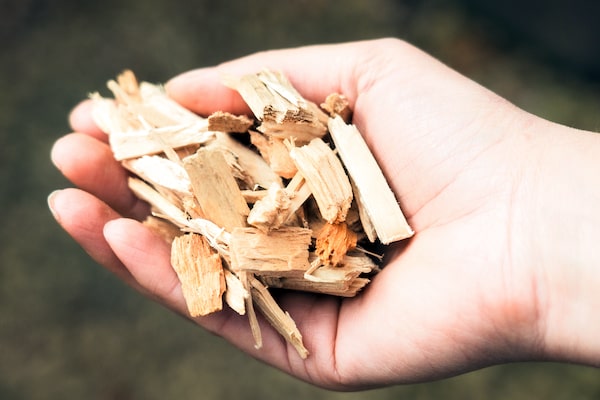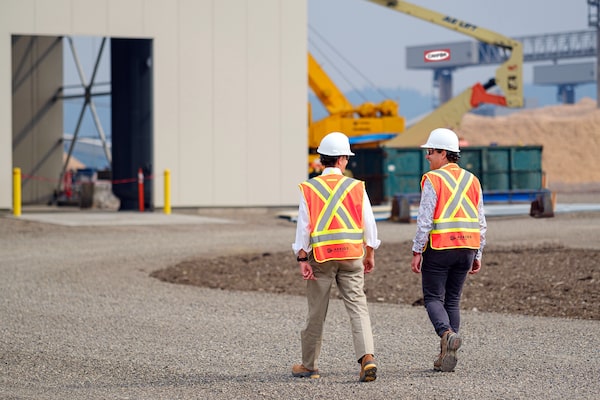
Innovators in Canada’s forest sector are turning low-grade wood into a renewable energy source.supplied
For innovation that helps fight climate change, look no further than Canada’s forest sector.
The industry is finding ways to use every part of a tree to help decarbonize the economy, from making household products out of wood fibres, to using mass timber in building construction. Another development is the increased use of biomass, which primarily consists of byproducts from tree harvesting, such as branches and low-grade wood.
These materials, previously considered less valuable, are now recognized as a high-value resource for the production of bioenergy due to their abundance and renewable nature. Turning biomass into bioenergy offers a sustainable alternative to fossil fuels, as the carbon released during conversion is part of the natural carbon cycle.
Bill Adams, vice-president of sustainability and innovation at Mercer International in Vancouver, explains that many pulp mills play a crucial and multifaceted role in the bioenergy sector. These mills not only meet their own energy needs but often produce surplus electricity to the broader power grid. By supplying renewable energy, Canada’s pulp mills play a vital part in addressing society’s increasing power demands while moving the country toward a sustainable, low-carbon energy future.
There’s another burgeoning use for biomass: fuel for district heating systems, says Jamie Stephen. The managing director of TorchLight Bioresources, a bioenergy consulting and project development firm, is helping to establish such a system in New Glasgow, N.S.
A district heating system is a network of underground, highly insulated hot-water pipes used to heat all the buildings in an area using a central plant fuelled by biomass, he explains. In most cases, these central plants co-generate electricity, ensuring a local, reliable supply and high plant efficiency.
“In many parts of the country, there’s a massive oversupply of low-grade wood, and using that wood for energy will allow us to implement active, climate-smart forestry,” Dr. Stephen says. Good forest management that prioritizes forest health and biodiversity requires a market for low-grade wood and residues. “[Canada] will not meet our climate goals without a significant district heating system build out, that’s without a doubt.”
Most cities and towns in heavily treed Sweden and Finland “are heated with wood chips – most people don’t realize that,” Dr. Stephen says. This includes Stockholm, Copenhagen (in Denmark), and Helsinki. Centralization of energy generation means these plants have lower air pollutants than natural gas furnaces. “That actually allows them to be the greenest cities in the world.”
Those countries actively manage their forests by thinning and removing trees in poor health or too closely spaced, ensuring that the remaining trees can grow larger, stronger and more resilient to pests and fire. People sometimes forget trees need light and space to grow big and healthy, he explains. Active management gives them the space they need and removes trees that could cause problems for the whole forest.

Arbios Biotech’s new plant in Prince George, B.C. will convert wood waste into sustainable bio-fuel for transportation industries.supplied
There are other emerging uses for biomass, says Ben Goodier, head of bio-innovation at Vancouver-based forest products company Canfor. Their joint venture, Arbios Biotech, is building a new plant in Prince George, B.C., to demonstrate a new technology called hydrothermal liquefaction, which uses heat and pressure to turn biomass into a liquid fuel that can then be added to products produced by oil refineries.
Government regulations now require petrochemicals to have a higher percentage of biofuels – fuel produced from plants or biomass – in their fuel or gasoline. “We will be providing a feedstock to the refineries, which is low carbon, so it will be part of a refinery’s mix to help them meet their requirements,” Mr. Goodier explains.
While this won’t necessarily “replace” the use of fossil fuels, it can be part of the solution to decarbonize Canada’s energy demands. Mr. Goodier says he expects bio-based fuel may become a much larger part of the aviation industry, for example, which can’t necessarily shift from fuels to batteries like the car industry can by going electric or using hydrogen fuels.
Taking advantage of the growing bioeconomy is “massively important for Canada,” he says, “because we have a lot of building blocks or raw material.” It may not be possible to only use batteries to power our lives to reduce our carbon footprints, he adds. “You’ll have to be getting the most value from each of these different solutions.”
Mercer and Canfor are among the forestry companies finding ways to break down tree residuals in innovative ways, such as turning cellulose into environmentally friendly additives to improve materials such as concrete, asphalt, plastic and various coatings.
“Many companies are looking to decarbonize their supply chain, and so they’re looking at alternatives like biomaterials where maybe a decade ago there wasn’t that incentive,” says Mercer’s Mr. Adams. “They recognize that their customers are looking for products that have a positive impact on climate change.
“We’re finally seeing now that there is an opportunity for the forest sector in Canada to invest in biomaterials and bioenergy. The market is ready for the uptake.”
The key to encouraging the bioeconomy – the use of bioenergy and biomaterials – for a variety of decarbonization efforts is to ensure there is stability for companies investing in these projects, Mr. Goodier says. “You need confidence that the markets are going to be there” and that regulations remain stable, he adds.
Fortunately, there is growing recognition of the importance of the bioeconomy in Canada’s fight against climate change. In its fall fiscal update, the federal government included forest biomass conversion technologies for heat and electricity generation in the Clean Technology and Clean Electricity Investment Tax Credits.
Mr. Goodier is optimistic that Canada will continue to advance its decarbonization efforts as the country aims to meet its greenhouse gas emission reduction targets. “This is something that we have to do. And I see a future where we are truly using those different resources in the most beneficial way,” he says.
“I believe that society will remain committed to it. There’s a lot of amazing things going on, so I’m optimistic. I think we’ll figure it out.”
Learn more about bioenergy and Canada’s forestry sector at forestryforthefuture.ca
Advertising feature produced by Globe Content Studio with Forestry For The Future. The Globe’s editorial department was not involved.